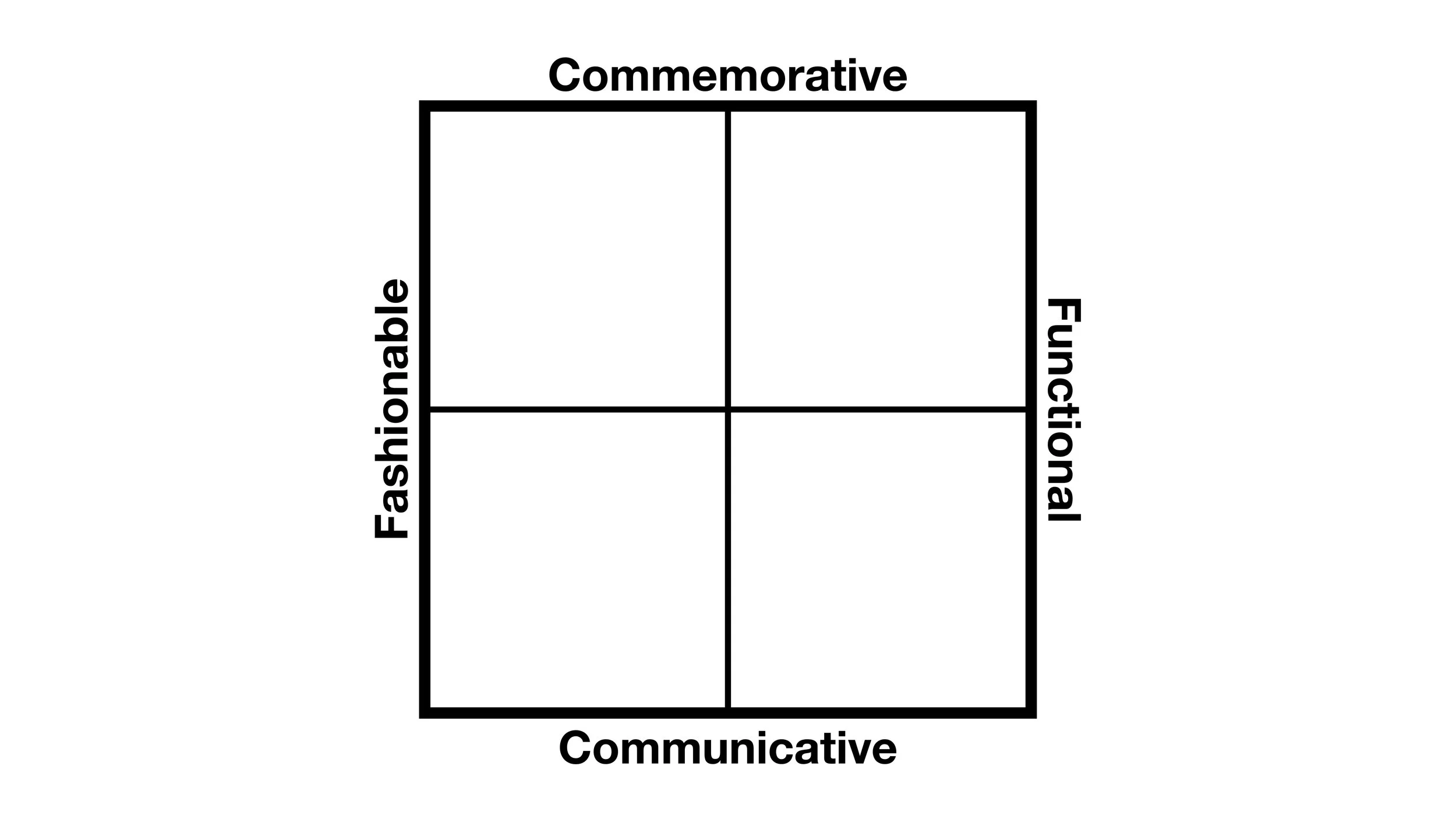T-shirt Categories
In our age of unbridled individualism, substantial attention is paid to “personality.” Outward displays are cultivated on social media, while inner discovery is promised by banner ads offering a variety of “personality tests.” Our society has a growing compulsion to describe and pronounce “who we are,” and this increasingly takes place online.
But must we submit to our fickle digital overloads? Must we remain fenced in by their glowing, battery-powered restraints? Must we accept baptism in this continued stream of boiling ones and zeros? Can we not still use the analog tools of our long forgotten ancestors to express our tendencies, styles, and aptitudes? To uncover our veiled inner nature?
T-shirts are the most commonly worn article of upper body clothing. Perhaps second only to the face, they are the visual cue that most closely and completely explains who a person is at a glance. They are an expression of our origins, our interests, our activities, our health, and yes, our personality. Tees are one of the first choices we make each morning and one that stays with us until the day ends.
T-shirt wearers receive feedback on their Tee choice from onlookers with whom they interact, they experience tactile sensation from the shirt material, and their sense of self is influenced by the look of the shirt on their torso. T-shirts are not only an outward representation of a chosen lifestyle; they also allow us to experiment, to learn about hidden lifestyles seeking a voice, or retire past styles that no longer serve.
It is well understood that different people, having different bodies, different values, different preferences, also have different collections of T-shirts. Most T-shirt collections, excepting those by extreme outliers, strive to maintain equilibrium between opposing forces. Control and freedom, past and future, attention and distraction, the group and the individual. A well-constructed Tee wardrobe should provide comfort, but not only in a limited, physical sense. The wardrobe should also align with who you are and how you fit into the world around you. It is part of the delicate and urgent dance we all perform as we endeavor to express an inner nature that is inexpressible.
The field of social T-shirt analysis is in its infancy and this piece is not meant as a comprehensive treatise on the topic. We only hope to give other passionate researchers a starting point. What follows is a novel schema for categorizing T-shirts and T-shirt wardrobes.
What’s the sitch with categorizing T-shirts?
A variety of existing methods could be used to categorize T-shirts. In the same way the food pyramid helps us conceptualize a balanced diet, we could first sort T-shirts into broad groups, then consider the relative amounts of each that comprise a balanced wardrobe. Using the Myers-Briggs approach, we could ask each T-shirt wearer their perceptions and preferences on a handful of shirt-related axes, then assess whether their physical wardrobe matches their idealized one.
In our research for this piece, we landed on a third option that strikes a balance between rigid shirt categorization and a wearer’s unique preferences. Two-by-two double-axis charts have been used in a variety of disciplines, perhaps most famously to understand categories of political thought.
Our initial impulse toward T-shirt categorization came from understanding how valuable these everyday shirts are in conveying the personality of the wearer. So, when developing our own double-axis plot, we chose categories that relate to how individuals choose their shirts and how this decision affects those around them.
Commemorative
The vertical axis of our figure, Commemorative vs. Communicative, describes how wearers and those they come in contact with interpret the text or imagery of a given Tee.
Commemorative T-shirts are those memorializing a past event or organization and, in general, are not meant to convey more than a memory. A shirt from that vacation, the blue one from your old job, that time you ran a 10K, the three shirts with the name of your college in various fonts, the music festival shirt, your rec kickball uniform from a few years ago. As you might imagine, this is one of the largest categories in the average wardrobe.
Many commemorative T-shirts are given for free to all participants. Others are purchased in a moment of fervor for a seemingly special event worthy of memorial that, upon later reflection, maybe is not. It is easy to let this category get out of hand, leaving you and your closet bloated and overwhelmed.
That said, commemorative Tees are easy to come by and generally unassuming. They are mortar in the foundation of a good T-shirt wardrobe, filling in the cracks and corners of dressers, always ready to be called upon when laundry day approaches. Those who prioritize this category of Tee include the general public, parents of youth athletes, chillers, younger siblings wearing hand-me-downs, burnouts, and grandparents of all sorts.
Communicative
There is a subtle, but important distinction between Commemorative Tees and Communicative Tees. As discussed above, Commemorative Tees are clothing that display the collected symbols of a life lived; Communicative Tees are messages that happen to be printed on clothing. Communicative Tees make a strong statement and invite a response.
A clear example of this category are T-shirts with jokes written on them. Most often these joke shirts have either a groan-worthy pun, overt misogyny, or a statement about how the wearer of the shirt “doesn’t care.” The T-shirt itself doesn’t matter so much as the message displayed on it.
T-shirts supporting an active political candidate or political affiliation are also more often Communicative than Commemorative, but there is certainly some categorical overlap. For example, wearing a “Make America Great Again” T-shirt is not an attempt to cover your torso with comfortable cloth, its a message. On the other hand, a fading Mondale-Ferraro ’84 T-shirt would only elicit vague memories of an uncontroversial past making the shirt, at this point, Commemorative.
Shirts with the logo of your favorite sports team can sometimes fall into the Communicative category, but it depends on the time of year and city you are in. Wearing a shirt representing a local sports team is usually not Communicative; these can be worn without feeling the gaze of passers by. Similarly, wearing the shirt of a team that is based far away and that hasn’t had much recent success against the local sports team is also usually more Commemorative than Communicative (e.g. wearing the T-shirt of a Minnesota professional sports franchise anywhere except Wisconsin). You do have to be aware when wearing a T-shirt that supports a team in direct competition with the local franchise; at that point you are inviting interaction with home fans who are often ruffians.
Communicative T-shirts occupy a smaller proportion of most wardrobes than Commemorative, but elicit more emotion and require greater energy when worn. Those who favor this category of shirt include tweens, teens, geeks, athletes and their fanatical fans, employees, a variety of assholes, and some well-meaning but misguided dads.
Fashionable
The horizontal axis of our figure describes whether a given Tee is primarily worn because of its outward appearance (Fashionable) or because of characteristics that make it appropriate for a specific activity (Functional).
Fashionable T-shirts are stylish and mostly text-free. They are often solid colors, or perhaps boldly patterned, and they fit the wearer well. It is not uncommon to see a small pocket on the left chest. Some sport V-necks instead of a traditional crew, others may have a few buttons left unclasped to show off a well-tanned upper chest.
Over time, the proportion of fashionable Tees within an individual wardrobe generally follows a characteristic bell curve; from youth through at least middle school there are few, if any, shirts that could be called “fashionable.” The proportion starts to rise somewhat in high school as kids try to fit in or attract love interests. The upward trend steadily continues through the 20s and well into the 30s, when there is generally a plateau that can last a decade or more, before the steady decline in fashionable shirts occurs from about age 50 and on. This describes a normal distribution for the populace, but of course may be shifted earlier or later depending on the temperament of the individual, if and how quickly they enter into a long-term monogamous relationship, whether they become a parent, etc.
It should be noted, there is frequently synergy between the Communicative category and certain types of shirt within the Fashionable category. Well-known, high-end fashion companies often sell shirts with their brand name prominently displayed. These shirts are pleasing to the eye, but they are also usually worn to communicate that the wearer is chic, posh, and dripping with cash.
Fashionable Tees are generally worn by people with accents, those in “the industry,” passengers of cars with tinted windows, salespeople working at stores selling Fashionable Tees, recent divorcés, people going to brunch, those with their name on the list at the klerb and, only briefly, by persons with a predominant Commemorative-Functional-type wardrobe before changing into “something more casual, who am I kidding.”
Functional
The fourth category to be discussed, though last, is certainly not least. A functional shirt is one that is donned in anticipation of a specific activity. Work-out shirts, the old one you paint in, oversized PJ Tees, the T-shirt portion of a Halloween costume, lucky T-shirts, medical scrub tops (which, yes, are technically T-shirts), a form-fitting long-sleeved Tee for avoiding sunburn while surfing or snorkeling, yard-work Tees, etc.
It goes without saying that every Tee that has ever been physically worn as clothing is “functional,” in a broad sense. But shirts in this category are worn because they are especially functional for a specific task due to the material they are made of, the cut of their jib, or cultural habits of dress. Interestingly, a T-shirt can be grandfathered into the functional category by an individual who chooses to wear it exclusively for a specific function (see above: the old one you paint in).
Everyone wears functional T-shirts at some point during their routine, it is just a question of how often. Those who prioritize functional Tees are handymen, purists, athletes, superstitious aunts, cool moms, and workers, among others.
Wardrobe Types
We have now established the four broad categories of our double axis T-shirt framework, Commemorative vs. Communicative and Fashionable vs. Functional. We believe this framework is valuable because it provides a common language for the new field of social T-shirt analysis, and facilitates systematic description of T-shirt wardrobes. It will also allow individual T-shirt owners to reflect on their wardrobe and evaluate whether any changes need to be made.
Of course, as with any attempt to order to a complex and boundless ecosystem, there will be grey areas when applying the theoretical T-shirt framework to real world situations. A given T-shirt may contain features from each category, or may change categories based on the context in which it is worn. Generally, to describe an individual wardrobe, T-shirt owners will have to do a shirt-by-shirt analysis, and even then particularly diverse or extreme collections may be challenging to place.
Below, we have added points of reference to our double-axis framework. These are meant to further describe wardrobe archetypes using examples of people who might sport those shirts. This is not meant to ascribe any value or ranking to the categories and is, of course, based only on limited and preliminary data. We feel a more thorough exploration of T-shirt wardrobe archetypes could be a fruitful direction for future research.





